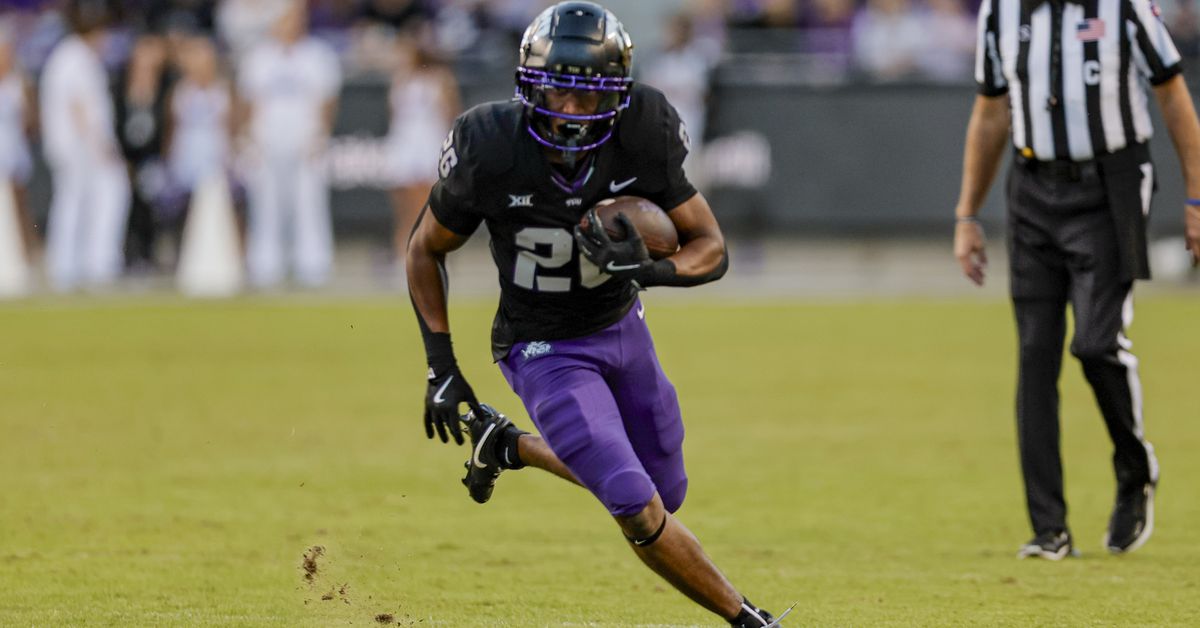The TCU Horned Frogs’ stable of running backs won’t look too much different from what it did a season ago. Last season’s starter, Cam Cook, departed the program, transferring to Jacksonville State. Furthermore, TCU’s fourth and fifth most utilized backs, Dominique Johnson and Trey Sanders, are no longer in Fort Worth. Yet, the three backs totaled merely 569 yards, while each averaged less than 4.0 yards per rush.
Cook began the season rather highly touted, but soon tumbled down the depth chart as the Horned Frogs instead featured do-it-all wide receiver Savion Williams and a slew of other backs, including freshman Jeremy Payne. All in all, Cook finished with 460 yards and nine touchdowns on 119 attempts for the Horned Frogs.
With Cook and Williams gone, TCU will presumably rely heavily on Payne. The sophomore back flashed in a limited role a season ago, rushing for 239 yards on 54 carries. Unlike most of TCU’s backfield, Payne displayed breakaway ability. Payne broke off two rushes for more than 30 yards this past season. For comparison, Cook’s longest scamper went for 19. The 5-foot-10 Texas native is perhaps the Horned Frogs’ most elusive back. He’s shifty, quick, and offers big-play explosion TCU so desperately needs from its backfield.
Moreover, Payne is a capable receiving threat. He hauled in 12 passes for 99 yards in 2024. Payne’s backfield mate, Josh Hoover, isn’t typically one to check it down, but Payne provides the All-Big 12 talent with a reliable dump-down option. However, with adjectives like quick and jittery comes a smaller stature. Not only is Payne 5-foot-10, but TCU lists him at only 180 pounds. Thus, rather than seeing a three-down role, Payne will likely split time with redshirt senior Trent Battle, UTSA transfer Kevorian Barnes, and redshirt freshman Nate Palmer.
Battle is likely Payne’s 1B, or even 1A, in the Horned Frogs’ backfield. The converted quarterback rushed for 186 yards and two touchdowns on 44 attempts a season ago. The 6-foot-1 back has played sparingly on offense across three seasons, totaling 249 rushing and 188 receiving yards through 35 appearances. Battle has primarily contributed on special teams, recording nine tackles and blocking a punt during his tenure in Funky Town. Yet, with a muddied backfield, Battle’s talents will be used on offense in 2025.
The former three-star quarterback isn’t as shifty as Payne, but that doesn’t mean he’s not one of the Horned Frogs’ best athletes. Battle is physically gifted, and at 200 pounds, he’s built to run both inside and out.
Speaking of interior rushing threats, Barnes is the Horned Frogs’ most rugged back. Listed at 5-foot-9, 210 pounds (he looks more like 220), the senior is a load to bring down. Barnes is decisive and runs hard. He frequently bounces off of would-be tacklers to gain extra yards. In four seasons at UTSA, Barnes totaled 1,797 yards and 14 scores.
#TCU Sonny Dykes says Jon Denman opened eyes in the spring.
Spoke highly of UTSA transfer Barnes as well.
Says Jeremy Payne was there most consistent last year
— J.D. Andress (@Jdandress11) August 1, 2025
Barnes’ best season came as a sophomore, when he racked up 845 yards while averaging 6.3 per tote. Despite back-to-back impressive seasons for the Roadrunners, Barnes was phased out as a senior. He accumulated only 221 rushing yards and averaged a measly 2.8 yards per rush. The redshirt senior will be in for a sizable role for the Horned Frogs. As TCU’s biggest back, expect Barnes to be featured around the goal line and in short-yardage situations.
Lastly, Palmer figures to receive a fair share of reps this season. The redshirt didn’t see the field often as a freshman, hence the redshirt. However, he did rush 10 times for 30 yards in the Horned Frogs’ New Mexico Bowl victory. Of the four backs, Palmer is the least experienced, yet arguably the most intriguing. Palmer rushed for 5,149 yards and 63 touchdowns for Decatur High School.
Other than the core four, freshman Jon Denman, sophomore Derrick Carroll, redshirt freshman Joe Pitchford, and senior Franklin Estrada II fill out the rest of the running back room. Of the four aforementioned backs, only Estrada II has received a rushing attempt. Although, as Sonny Dykes proclaimed, Denman has impressed throughout the Spring, paving the way for future playing time.
